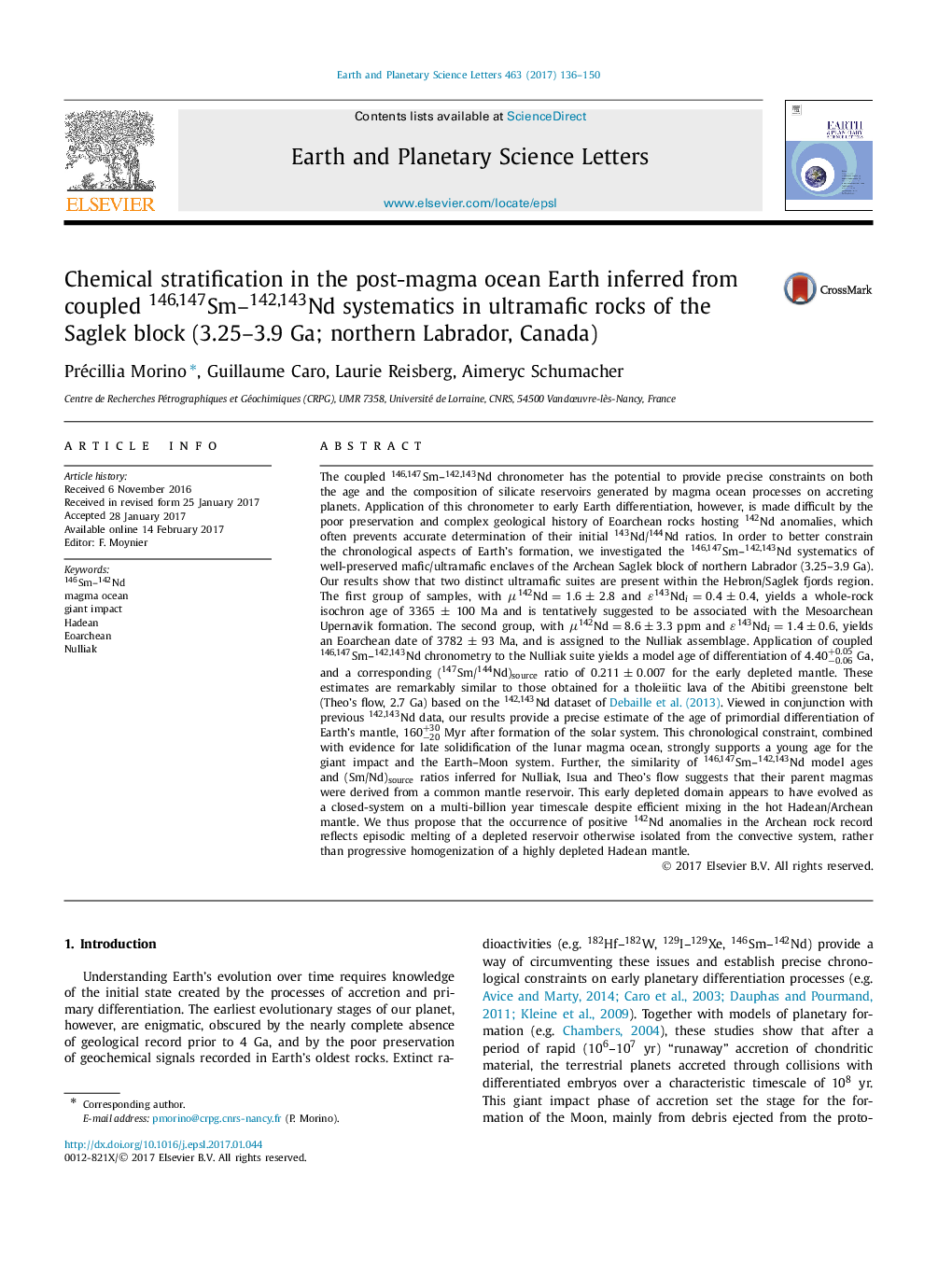| کد مقاله | کد نشریه | سال انتشار | مقاله انگلیسی | نسخه تمام متن |
|---|---|---|---|---|
| 5780098 | 1634693 | 2017 | 15 صفحه PDF | دانلود رایگان |
عنوان انگلیسی مقاله ISI
Chemical stratification in the post-magma ocean Earth inferred from coupled 146,147Sm-142,143Nd systematics in ultramafic rocks of the Saglek block (3.25-3.9 Ga; northern Labrador, Canada)
دانلود مقاله + سفارش ترجمه
دانلود مقاله ISI انگلیسی
رایگان برای ایرانیان
کلمات کلیدی
موضوعات مرتبط
مهندسی و علوم پایه
علوم زمین و سیارات
علوم زمین و سیاره ای (عمومی)
پیش نمایش صفحه اول مقاله

چکیده انگلیسی
The coupled 146,147Sm-142,143Nd chronometer has the potential to provide precise constraints on both the age and the composition of silicate reservoirs generated by magma ocean processes on accreting planets. Application of this chronometer to early Earth differentiation, however, is made difficult by the poor preservation and complex geological history of Eoarchean rocks hosting 142Nd anomalies, which often prevents accurate determination of their initial 143Nd/144Nd ratios. In order to better constrain the chronological aspects of Earth's formation, we investigated the 146,147Sm-142,143Nd systematics of well-preserved mafic/ultramafic enclaves of the Archean Saglek block of northern Labrador (3.25-3.9 Ga). Our results show that two distinct ultramafic suites are present within the Hebron/Saglek fjords region. The first group of samples, with μ142Nd=1.6±2.8 and ε143Ndi=0.4±0.4, yields a whole-rock isochron age of 3365 ± 100 Ma and is tentatively suggested to be associated with the Mesoarchean Upernavik formation. The second group, with μ142Nd=8.6±3.3 ppm and ε143Ndi=1.4±0.6, yields an Eoarchean date of 3782 ± 93 Ma, and is assigned to the Nulliak assemblage. Application of coupled 146,147Sm-142,143Nd chronometry to the Nulliak suite yields a model age of differentiation of 4.40â0.06+0.05 Ga, and a corresponding (147Sm/144Nd)source ratio of 0.211±0.007 for the early depleted mantle. These estimates are remarkably similar to those obtained for a tholeiitic lava of the Abitibi greenstone belt (Theo's flow, 2.7 Ga) based on the 142,143Nd dataset of Debaille et al. (2013). Viewed in conjunction with previous 142,143Nd data, our results provide a precise estimate of the age of primordial differentiation of Earth's mantle, 160â20+30 Myr after formation of the solar system. This chronological constraint, combined with evidence for late solidification of the lunar magma ocean, strongly supports a young age for the giant impact and the Earth-Moon system. Further, the similarity of 146,147Sm-142,143Nd model ages and (Sm/Nd)source ratios inferred for Nulliak, Isua and Theo's flow suggests that their parent magmas were derived from a common mantle reservoir. This early depleted domain appears to have evolved as a closed-system on a multi-billion year timescale despite efficient mixing in the hot Hadean/Archean mantle. We thus propose that the occurrence of positive 142Nd anomalies in the Archean rock record reflects episodic melting of a depleted reservoir otherwise isolated from the convective system, rather than progressive homogenization of a highly depleted Hadean mantle.
ناشر
Database: Elsevier - ScienceDirect (ساینس دایرکت)
Journal: Earth and Planetary Science Letters - Volume 463, 1 April 2017, Pages 136-150
Journal: Earth and Planetary Science Letters - Volume 463, 1 April 2017, Pages 136-150
نویسندگان
Précillia Morino, Guillaume Caro, Laurie Reisberg, Aimeryc Schumacher,